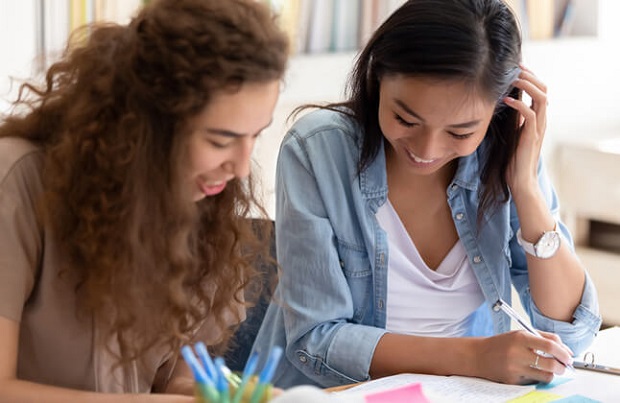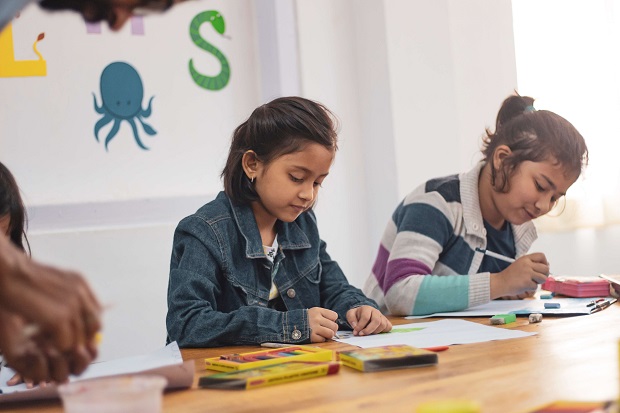
Does your class groan when you mention editing their work? Students can find it difficult to change their writing. Once their first draft is complete, they are desperate to move on to something new. As teachers, it’s hard to make them value and enjoy the process of proof-reading and editing.
Peer editing is an important part of formative assessment that allows students to support each other. It can reduce your workload and encourage learners to take responsibility for their work.
What Is Peer Editing?
Good peer editing goes much further than a simple spell check at the end of a piece of writing. It's a process. Students work with a partner to read and refine their work.
Learners find it hard to hear that their writing needs improving. Making it a collaborative process allows them to hear an honest opinion from a friend. They can then help their partner with the same process.
Why Use Peer Editing?
If students find peer editing difficult, why do we bother teaching it? Well, editing is an important shift towards understanding that writing doesn’t end with a first draft.
Peer editing helps learners take ownership of their work. They improve it independently, without relying on you to tell them what to do. This is a big reduction in teacher workload and removes the bottleneck feeling where every student waits to receive individual feedback from you.
When writing, two heads are better than one. A collaborative practice helps children see their work from a different perspective. They can make changes to improve clarity and meaning.
How to Include Peer Editing in Your Classroom
Embed peer editing within the writing process, don’t treat it as an add-on. Make it an integral part of writing by building in enough time. Don’t expect your students to know automatically what you expect. Dedicate time for the direct teaching and modeling of peer editing skills.
Use high-quality examples, called ‘What a Good One Looks Like’ (known as WAGOLLs) to let your learners see what you are expecting. Annotate and unpick the successful features of a WAGOLL as a class and discuss how they could apply this to their own writing.
Most professional writers finish a first draft then leave it for as long as possible. When they edit their work, they are looking at it with fresh eyes. Try this technique with your learners by separating out the writing and editing sections, interleaving it with a different project.
Peer Editing Techniques
Often students find editing a boring process, but it really doesn’t have to be. Simple changes can make it feel fun.
Why not try:
- Letting students use colored sticky notes to write their edits
- Displaying work on a visualizer or photocopying for the class to see
- Using colored highlighters and pens to show the changes
- Editing via email
- Using an online editor such as ProWritingAid
Successful peer editing needs a clear purpose, or it can feel overwhelming. Don’t change too much at once. Ask yourself, what is the most important thing I want my students to develop? Decide as a class your criteria for success.
Editing is a difficult process, so value the changes and make use of them. Display pre- and post-edited work on a wall display or in a class book or blog. This shows that time spent editing has a purpose.
Start with Proofreading
Often students are distracted by simple grammatical and spelling mistakes. This stops them seeing wider changes they could make.
Try using these simple tips with your class for effective proofreading:
- Read work aloud to their partner
- Use a dictionary to self-correct spellings
- Provide a word mat of technical vocabulary needed
- Ask partners to read their work
- Check the tense of the piece remains consistent
Give them a set amount of time to correct spelling, punctuation, and grammar before moving on to developmental changes.
Developmental Editing
After proofreading, your students will be less distracted by obvious errors. Use questions to help your learners find positives and developmental areas to work on.
Key questions to ask:
- Does each paragraph make sense?
- Are my paragraphs in the right order?
- Which points are unclear or not detailed enough?
- Have I achieved the success criteria?
Give your students a template or guide to help them with editing. Sentence starters can help students who struggle to know what to say to their partner.
Building Peer Relationships

Peer editing can often fill students with dread. Showing your work to someone else is an intensely personal experience and needs treating with sensitivity.
To find the best partnerships:
- Put struggling learners with middle-ability students
- Partner your highest achieving students with secure middle-ability students
- Avoid placing best friends together unless you know they will work well
- Allow time to build a relationship
- Set clear expectations and rules to make sure peers are supportive of each other
Choose your peer editing partners wisely. Each partnership needs to be supportive but also effective.
Mark Gardner, writing in Edutopia, uses the acronym SPARK to help students understand what quality feedback looks like:
- Specific: Link comments to a discrete word, phrase, or sentence
- Prescriptive: They offer a solution or strategy
- Actionable: Students know what steps to take to improve
- Referenced: The feedback directly links to the task criteria
- Kind: Frame comments in a supportive way
Final Thoughts
You can’t achieve successful peer editing overnight. Learners need to be taught how to give and receive feedback in a supportive way. Using WAGOLLs, writing frames and sentences starters will help them know what to say to their partner.
Peer editing can be an enjoyable experience by building positive relationships and valuing the time spent making changes. For teachers, peer editing offers huge potential for workload reduction and encourages students to become independent.
It must be more than a bolt-on and requires time to embed, but the results in your classroom will be well worth your efforts.

